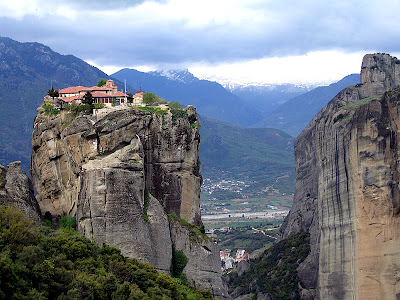Meteora, Greece’s city in the sky
The Holy Monastery of Rousanou, one of the
six still in operation in Meteora, was founded around 1545.
(Jean-Pierre Lescourret/LPI)
Above the town of Kalambaka, on the north-western edge
of Greece’s Plain of Thessaly, giant rock formations reach nearly 400m
into the sky, like something out of a science fiction movie. Balanced
across 24 pillars are monasteries, visible through the clouds.
Numerous geologists and historians have tried to fathom how the giant rock pedestals were created an estimated 60 million years ago, but no theory has been fully proven. Today, the enormous fingers pointing to the heavens are a protected Unesco World Heritage Site and go by the name Meteora – which literally means “suspended in the air”.
It is said that the first people to inhabit Meteora arrived in the 9th Century. In a bid to escape everyday life, they braved fierce storms and climbed up the cliffs with their bare hands. Grabbing at trees as they went, they eventually settled in small caves and crevices and embarked on a life of solitude, meeting occasionally to worship and pray. For hundreds of years the only way to bring anything up or down the rocks was with nets or baskets attached to rope. As time progressed the cave dwellers grew into a small community focused around the growing number of monasteries, which by the 14th Century served as shelter from Turkish invaders.
The journey to Meteora (a 4- to 5-hour drive from Athens) is full of steep, winding roads. Once you are standing on top of the rocks, staring at nature in its grandest form, you will most likely feel small and irrelevant in comparison. Six of the monasteries are still in operation, and it is a trip worth taking for the views alone.
The Monastery of the Great Meteoron, founded in the 14th Century by Saint Athanasios, is the highest, largest and oldest of the six. If there is only time to visit one monastery, this is the one to choose. Do not miss the well preserved frescoes depicting scenes from the life of Christ. The kitchen is still black with smoke and contains the original bread oven and soup hearth. You can also meet the former monks of the monastery at the sacristy, where their skulls and bones are neatly stacked on shelves.
The Holy Monastery of Varlaam is the second largest. Two rich monks took over the site in the 16th Century and it took more than 20 years to hoist all of the building materials to the top. You can still see the old rope basket that lifted the supplies.
Compared to the others, the Holy Monastery of Rousanou is lower in elevation, making it more accessible. It was founded around 1545 but was damaged by the Germans during World War II. Since 1988 it has been occupied by nuns.
The Holy Monastery of St Nicholas houses a single-nave church with a small dome, decorated by the 16th-century Cretan painter, Theophanes the Monk. Each monastery houses an impressive collection of Byzantine art – some of the most beautiful in all of Greece.
The Holy Monastery of St Stephanos was founded around 1400 and is now a convent with wonderful views of the Pinios River. If you ask them, the nuns will take the time to tell you about their daily routine and the history of their home.
Painting icons is a skill that many of the monks and nuns continue to practice and you will probably see them perfecting their latest piece of art. It is a painstakingly slow process, with an icon taking many months to complete. The old katholikon (chapel) at St Stephanos, which was rebuilt in 1545, is still standing, but was heavily damaged during WWII and the civil war throughout the 1940s, so many of the icons contain bullet holes.
The Monastery of the Holy Trinity is accessible by climbing 140 steep steps, making it one of the least visited. It was used in the final scenes of the James Bond film For Your Eyes Only.
It is an energetic climb up to any of the monasteries, the most difficult to reach being the Great Meteoron. But once you arrive, it is easy to understand why the first hermits were so determined to reach Meteora’s peaks though and why the monks and nuns who now reside there say they would not dream of living anywhere else. Sister Charitini Karanasio grew up nearby, and she fell in love with the area as a little girl. She now lives in St Stephanos.
“This is a place where lots of saints have lived and I have always been in awe of the area,” Sister Charitini Karanasio said. “Somehow being up here makes me think my prayers will reach God much more quickly.”
At the foot of the rocks, Panorama offers good food right from the oven. The kolokithokeftethes (zucchini fritters), souvlaki and mushrooms are delicious.
Source: http://www.bbc.com/travel/feature/20110715-meteora-greeces-city-in-the-sky



No comments:
Post a Comment